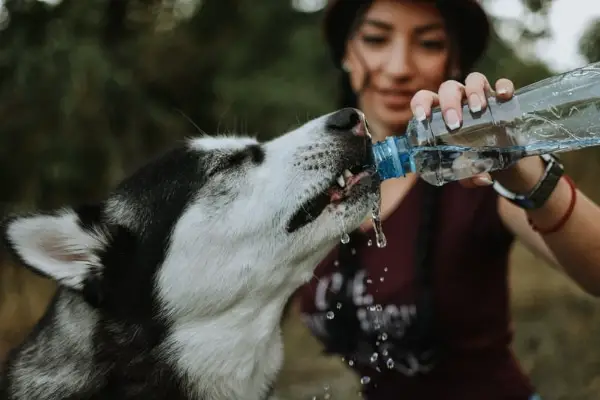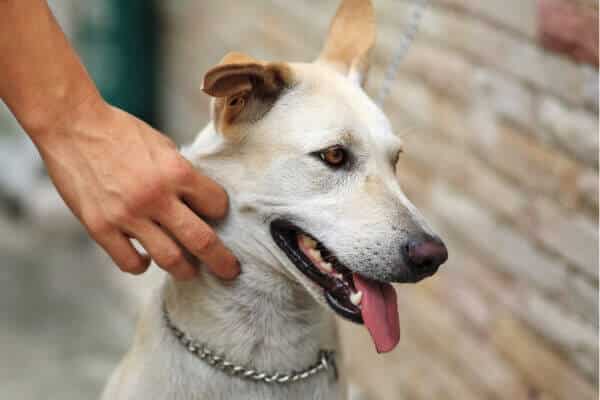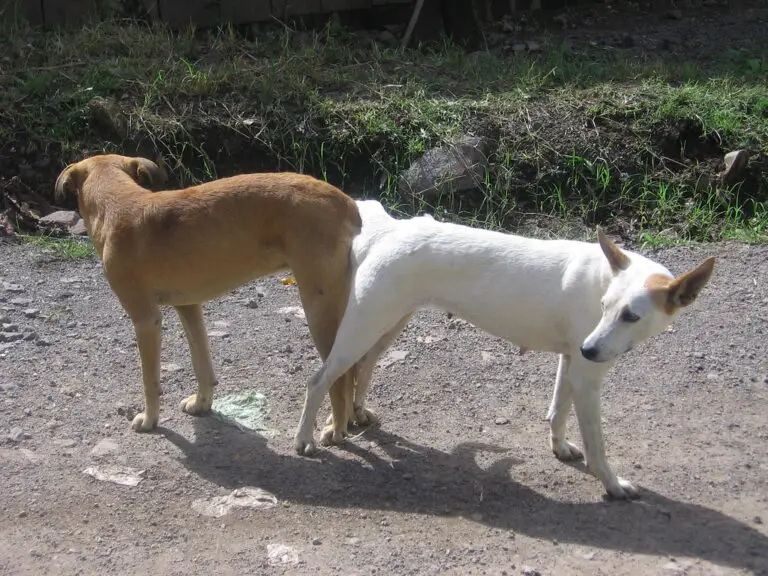Mother Dog Aggressive Towards Father And Won’t Let Him Near Puppies

Dogs have various instincts that they inherited from their wolf ancestry, which have enabled their survival through different rough ages. One of those is maternal aggression which serves the evolutionary purpose of warding off fertile males from pregnant females to allow them to mate with other females.
From a plain perspective, mother dog aggression towards the father, often leading to the restriction of his access to their puppies, stems primarily from her powerful instinct to safeguard her newborn litter. Newborn puppies are helpless and entirely reliant on their mother for survival. In this vulnerable state, the mother dog’s natural protective instincts kick in, compelling her to fend off any perceived threats to her pups, even if that threat is the puppies’ father.
In the dog world, maternal aggression is not a reflection of animosity towards the father but an expression of the mother’s overwhelming instinct to ensure her puppies’ safety. Let’s delve into deeper into these reasons?
Why Is My Mother Dog Aggressive Towards The Father and Won’t Let Him near puppies?
A mother dog acting aggressively towards the father and his interaction with his puppies can be a source of concern for pet owners, as this is not usual for humans. Here are several reasons why your female dog may display such behavior:
1. She’s Protecting Her Puppies
This is perhaps the most common reason for such behavior. A mother dog’s primary role after giving birth is to protect her young. This behavior is ingrained in her from her wild ancestors, who often had to guard their offspring against predators.
Newborn puppies are incredibly vulnerable and are entirely reliant on their mother for their survival. During the initial weeks, they are unable to see, hear, or fend for themselves. This high vulnerability means that the mother dog has to be constantly alert to potential threats. Even though the father dog may mean no harm, the mother dog doesn’t want to take any chances. In her eyes, the father dog is another potential threat to her puppies’ safety.
In some cases, the father might be overly curious or playful, which might upset the mother. If the mother dog perceives even a slight risk to her puppies from the father dog, she will display aggressive behavior to ward him off. This aggression isn’t personal. It’s a manifestation of her primal instinct to ensure her puppies are safe.
2. Hormonal Changes
The process of pregnancy and giving birth initiates significant hormonal changes in a female dog. These hormonal shifts can heighten her senses and make her more protective. Progesterone, which maintains pregnancy, and oxytocin, which triggers labor and milk production, play a significant role in this process.
After birth, there is a sharp decline in progesterone and a rise in prolactin to stimulate milk production for nursing puppies. These shifts can lead to behavioral changes in the mother dog. She can become more aggressive, especially if she believes that her puppies are in danger. It’s important to remember that these changes are usually temporary. As the hormone levels return to normal and her puppies grow and become less dependent on her, the mother dog’s aggression should also decrease. In case of pseudopregnancy, maternal aggression often exists and this is solely due to hormonal changes.
3. To Eliminate Distraction and Stress
Nursing and caring for puppies require a lot of energy and focus. Newborn puppies need to be fed every few hours, and the mother dog has to keep them warm and safe. The presence of other dogs, including the father, can be distracting. Too much activity around her might disturb the mother dog when she’s trying to nurse or rest with her pups.
Furthermore, the added stress of constantly monitoring the father dog’s actions could lead to heightened aggression. To keep distractions to a minimum and to maintain a calm and stable environment for her puppies, the mother dog might act aggressively to keep the father dog at a distance.
4. She Feels Threatened
Even in the absence of an immediate threat, a mother dog might perceive one based on her instincts. Mother dogs are highly intuitive and attentive to their surroundings. If the father dog’s behavior or actions seem threatening or invasive to her, she may respond with aggression.
The mother dog’s perception of a threat could be based on the father dog’s past interactions with her or the puppies, his body language, or his actions around the puppies. She doesn’t want to risk her puppies’ safety and will use aggression as a deterrent to keep the father dog away.
It’s crucial to note that this behavior is typically instinctual and not a sign of an inherently aggressive or bad dog. However, if a mother dog’s aggression seems overly severe or persists even after the puppies are older and weaned, it might be advisable to seek professional help. Consulting with a veterinarian or a dog behaviorist can provide useful insights and solutions to manage such behavior effectively.
5. Survival Instinct
It’s important to consider that, evolutionarily, dogs have adapted to increase the likelihood of their survival. This survival instinct isn’t limited to personal survival but extends to the survival and success of their genetic lineage. The mother dog’s aggression towards the father dog may, in part, be an evolutionary strategy to maximize the genetic distribution of the father.
In the wild, once the male has mated with a female and she has given birth, his role in the genetic continuation is essentially complete. If he spends time around the puppies, it is time that he isn’t using to find other females to mate with. By acting aggressively towards the father, the mother dog may be encouraging him to move on and mate with other females. This behavior could thereby increase the number of offspring carrying the father’s genes, which could be beneficial from an evolutionary perspective.
Mother Dog Won’t Stay In The Whelping Box. (7 Reasons & When To Worry)
Can Father Dogs Be Around Newborn Puppies Or Should You Separate Him?
Father dogs usually have no interest in caring for their pups, hence, their presence isn’t necessary for the pups’ development and can potentially disrupt the mother’s caregiving. Therefore, it’s generally recommended to separate the father from the mother and puppies, especially if the mother dog shows signs of stress or aggression.
Even if the father has shown no signs of aggression towards the puppies, the mother’s protective instincts might perceive his presence as a potential threat, causing stress and potential conflicts. Therefore, keeping the father dog separated initially can help provide a peaceful environment for the mother and her puppies
Also, father dogs do not have paternal instincts and hence do not typically participate in puppy care and are often indifferent to the puppies. While some male dogs may exhibit curiosity about the new arrivals, their involvement in puppy care is next to zero.
Considering that newborn puppies are extremely fragile. Larger breed fathers, possibly being unaware of their size and strength, could inadvertently harm the puppies. This is more of a risk during unsupervised interactions. Even something as innocent as a father dog trying to play with a puppy could result in injury due to the size and strength difference.
Typically, a safe time to introduce the father dog to the puppies is once they’re a bit older and more mobile, usually around the four to six-week mark. By this time, the puppies are stronger and less vulnerable, and the mother dog may be less protective. However, this timing can depend on the individual dogs and their behaviors.
How long do you keep male dogs away from puppies?
The timing of when to introduce a male dog, particularly the father, to puppies can be a nuanced issue. It largely depends on the individual behaviors of both the mother and father dogs, as well as the development of the puppies. However, a general guideline is to keep male dogs away from the puppies for about the first 3 to 4 weeks of their life.
During the first few weeks, the puppies are extremely vulnerable. They are born with their eyes and ears closed, and their primary focus is nursing and sleeping. The mother dog is also recovering from giving birth during this period and might be more protective of her puppies. The father’s presence can be a distraction, create unnecessary stress, and possibly lead to conflicts, particularly if the mother dog feels her puppies are under any sort of threat.
Typically, around the 3 to 4-week mark, the puppies start to become more active. They begin to explore their surroundings, their eyes and ears are open, and they start to develop some degree of independence from their mother. It’s also usually around this time that the mother dog begins to spend a bit more time away from her puppies, though she’s still very much involved in their care.
Introducing the male dog to the puppies at this stage, under supervised conditions, can be beneficial. It allows the father to get accustomed to the puppies and vice versa, promoting socialization. However, it’s best to introduce the father to the puppies gradually and monitor these interactions closely to prevent any potential harm to the puppies.
In some cases, the mother dog might remain aggressive towards the father even after this period, in which case it may be necessary to keep them separated for a longer duration. On the other hand, if both the parents are getting along well and there’s no sign of aggression or stress, you might decide to introduce the father to the puppies a bit earlier.
Keep in mind that these are general guidelines, and every dog and situation can be unique. If you have concerns about the best time to introduce a male dog to the puppies, or if there are signs of aggression or stress, it’s always a good idea to consult with a professional, such as a vet or a dog behaviorist. They can provide specific advice based on your situation and the behaviors of your dogs. Always prioritize the safety and well-being of both the mother dog and her puppies when making such decisions.
How do you stop maternal aggression in dogs?
1. Keep The Mother Dog Separated
The first step in managing maternal aggression is to provide a separate, quiet space for the mother and her puppies. This arrangement allows for the mother dog’s instincts to protect her litter without unnecessary triggers or disturbances that might escalate her protective behavior.
Separation in this context doesn’t mean isolating the mother dog and her puppies entirely. It refers to creating an environment where they can have some privacy and tranquility. This could be a separate room or a cordoned-off area within a room, depending on your living situation.
The key is to limit the exposure to other pets, particularly other dogs or the puppies’ father, especially during the initial weeks after birth. The mother dog needs to feel secure in her environment to successfully nurture her puppies without the added stress of defending them from perceived threats.
Another reason for keeping the mother dog separated is to control the interactions between her and human family members. While it’s important to regularly check on the mother dog and her puppies, too much human interaction in the early days can be stressful for the mother and trigger aggression.
2. Give Her The Gift Of Time
Just like humans, dogs need time to adapt to significant life changes, and giving birth is one of the most profound changes a female dog can experience. As the weeks pass, her hormonal levels will stabilize, and her puppies will become less vulnerable and dependent. Over time, she will naturally start to become less protective and aggressive.
Moreover, this is the best time to constructively shape her behavior. The goal is to create an association between your presence or the presence of the father dog near the puppies and positive outcomes for her.
When you and the father dog enter the room where the mother dog and her puppies are, bring with you treats that the mother dog finds particularly appealing. This is important as these treats will serve as a bridge, linking your presence near the puppies to positive reinforcement.
Without any attempt to make contact with her puppies, you can casually throw some treats toward her. This strategy helps her to associate your visits to the puppies with a rewarding experience. Over time, as she becomes more comfortable with your presence and the presence of the father dog, you can gradually increase interactions with the puppies.
3. Ensure They Are Comfortable
One of the most effective ways to reduce maternal aggression in dogs is to ensure that the mother and her puppies are as comfortable as possible.
Comfort for a new mother dog extends beyond just physical comfort, it encompasses a sense of safety and security. A significant part of this involves providing a calm and peaceful environment. An area that’s quiet, free from frequent disturbances, and has limited access to other pets in the house, can give her the peace she needs.
Physical comfort is vital too. Provide a suitable whelping box or bed that is warm and cozy for her and the puppies. It should be spacious enough for the mother to move around, but also secure enough to prevent the puppies from wandering away.
The availability of fresh water and nutritious food at all times is also crucial. Remember, a nursing mother dog’s nutritional needs are much higher, and fulfilling these requirements contributes to her overall comfort.
Finally, hygiene plays an important role in the mother dog’s comfort. Ensure the area where she and her puppies are staying is clean and dry. Frequent removal and replacement of bedding material will help maintain cleanliness and reduce the risk of infections.
4. Spaying Your Female Pooch
Spaying, or surgically removing the ovaries and uterus, eliminates the possibility of future pregnancies and can help reduce aggressive behavior in dogs. Spaying removes the hormonal fluctuations associated with the reproductive cycle. However, it’s important to wait until the mother dog has completely weaned her puppies and her milk has dried up before considering this surgery. It’s recommended to consult with a vet to determine the best time to spay a female dog after giving birth.
Do dogs recognize their father?
Dogs primarily rely on their senses of smell and, to a lesser extent, sight to identify individuals. In a litter of puppies, the father does not usually participate in raising the offspring and may not be around during their early developmental stages. Therefore, puppies typically won’t have the opportunity to establish a scent bond with their father.
If the father dog has been absent since shortly after the puppies’ birth, it’s unlikely that the puppies would recognize him later on, especially once they have left their birth environment. It’s also important to note that dogs do not have a concept of biological relationships the way humans do. They don’t inherently understand the concept of a biological father or mother.
However, if the father has been present in the puppies’ lives regularly, it’s possible for the puppies and the father to form a recognition based on familiarity rather than biological relations. This bond would be more akin to the bond dogs form with their human family members or other animals they regularly interact with.
Why is my dog scared of puppies?
Just like humans, every dog has its unique personality. Some are naturally more outgoing and playful, while others are more reserved or shy. More introverted dogs may feel overwhelmed by the high-energy play style and constant curiosity of puppies, leading to stress or fear. In such cases, it’s crucial to respect your dog’s boundaries and provide a quiet and safe space for them to retreat to when they feel overwhelmed.
There are cases where your dog may be scared of puppies due to a lack of socialization. When dogs are young, they must have the opportunity to interact with a variety of people, environments, and other animals, including other dogs and puppies.
This socialization period, typically before 14 weeks of age, plays a significant role in shaping how comfortable a dog feels around others. Dogs that weren’t adequately socialized during this period might find the high-energy and unpredictable behavior of puppies unsettling, leading to anxiety or fear.
The dog’s past experiences with puppies or other dogs can also significantly impact how they react to puppies. If they have had negative experiences, such as being bullied or overwhelmed by more boisterous dogs or puppies in the past, this can lead to fear. Dogs have excellent memories when it comes to emotionally charged events, and these negative experiences can cause lasting impressions, leading them to be wary or fearful around puppies to avoid any potential harm.
Final Thoughts
The display of aggression by a mother dog towards the father is generally a normal behavior and a manifestation of her primal instinct to protect her young ones. Recognizing this behavior as a protective mechanism rather than a personal attack can help in managing it effectively.
While it can be distressing to see aggression between your pets, patience and understanding can help you navigate this challenging phase. Remember, this period is temporary and will pass as the puppies grow and become less dependent on their mother.
Providing a separate, quiet, and comfortable environment for the mother dog and her puppies can go a long way in mitigating stress and aggressive behavior.
Moreover, you can ease tension over time by slowly introducing the father dog and rewarding the mother dog for less aggressive behavior. It’s always a good idea to consult with a professional, such as a vet or a dog behaviorist, if the aggression persists after the pups are weaned.
Read related posts about





